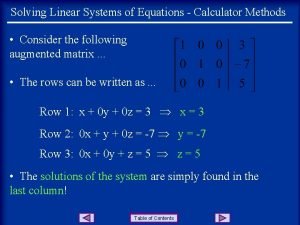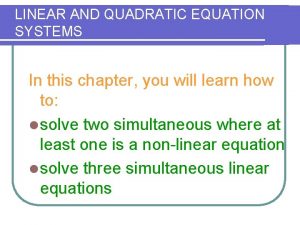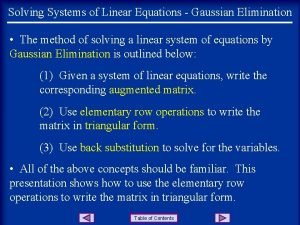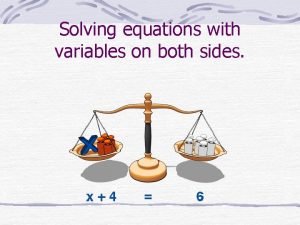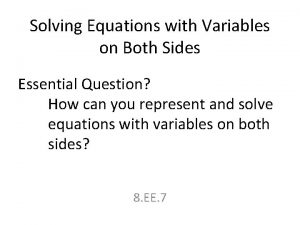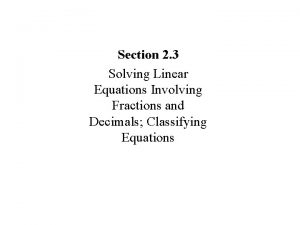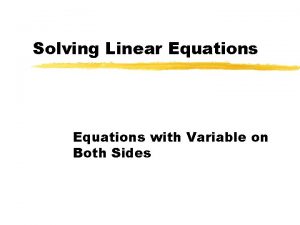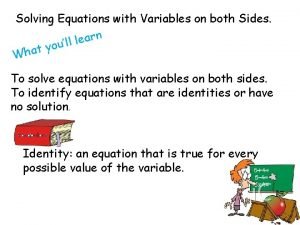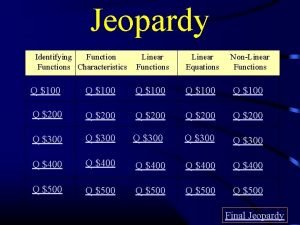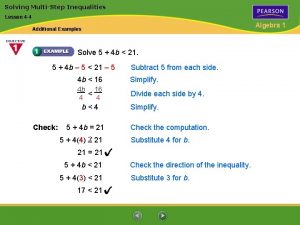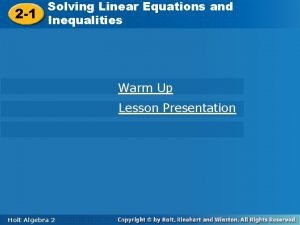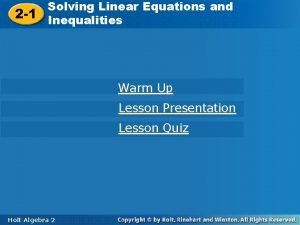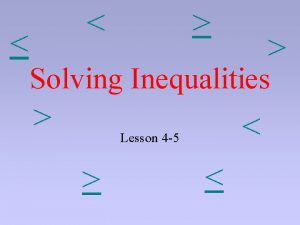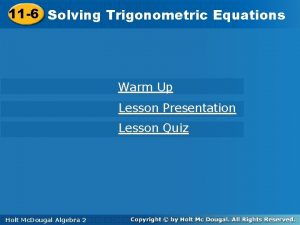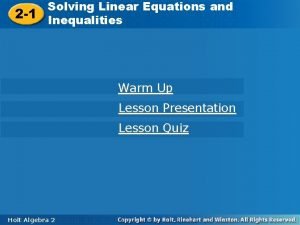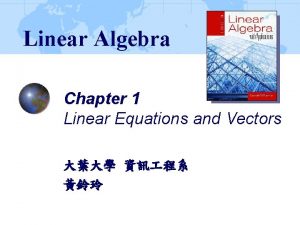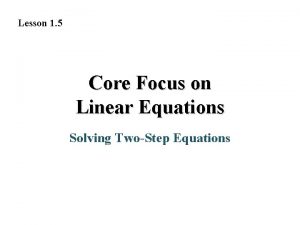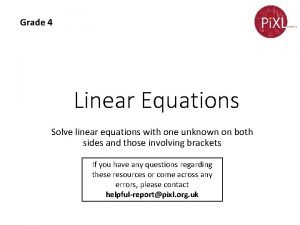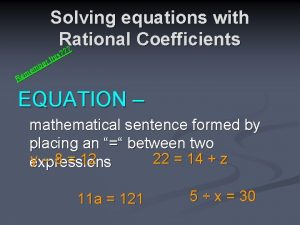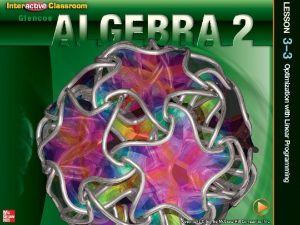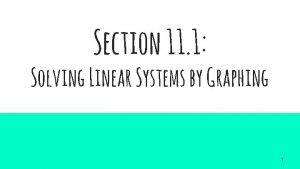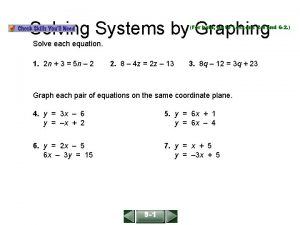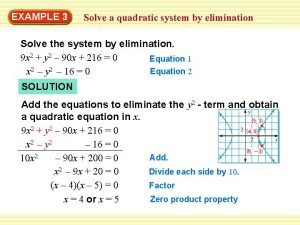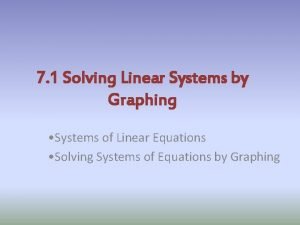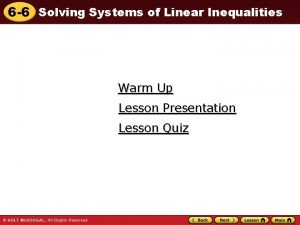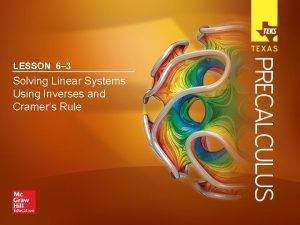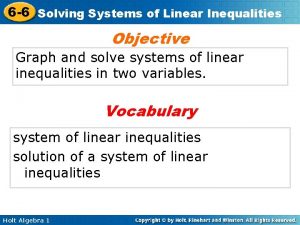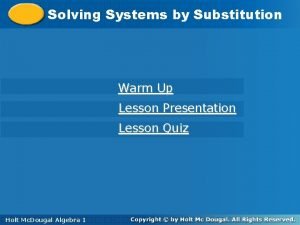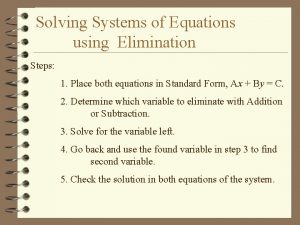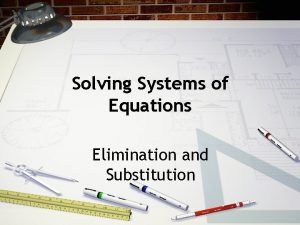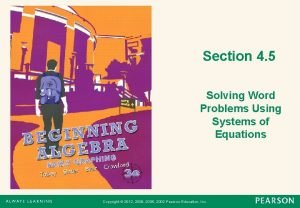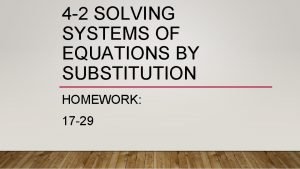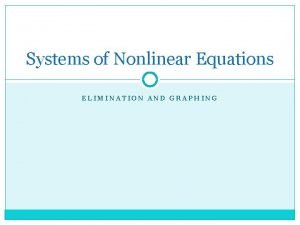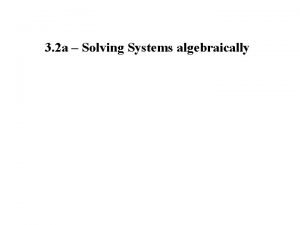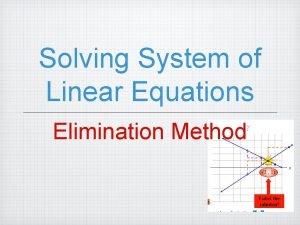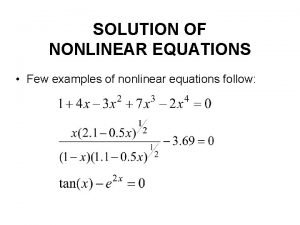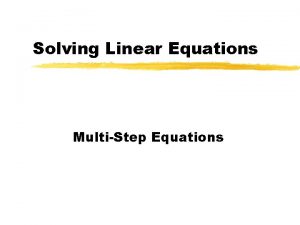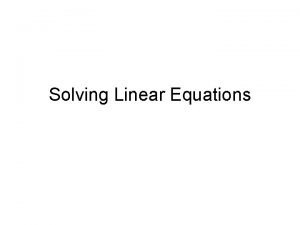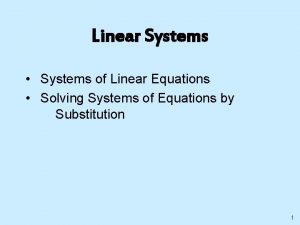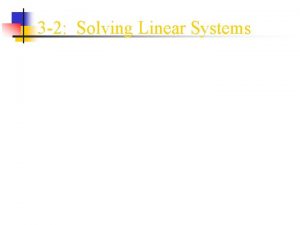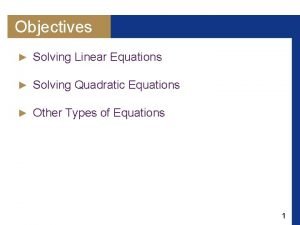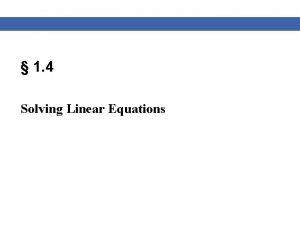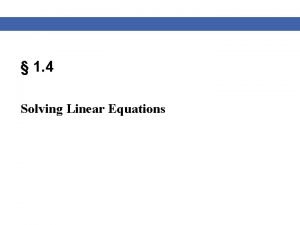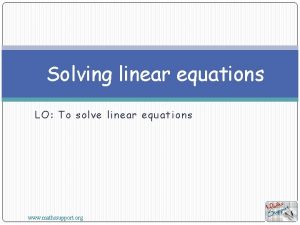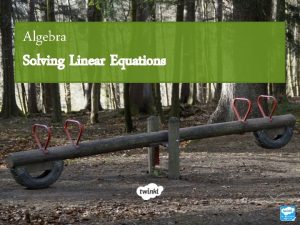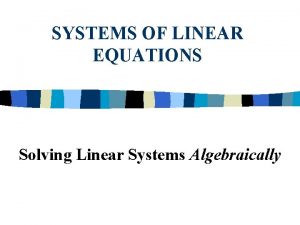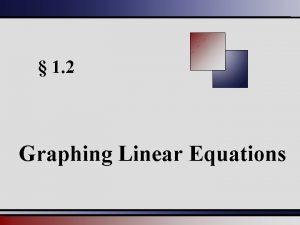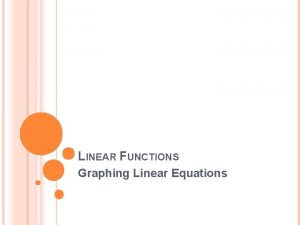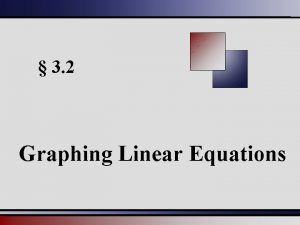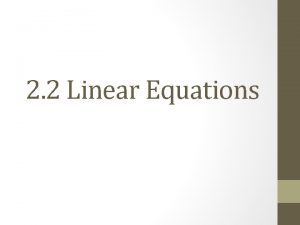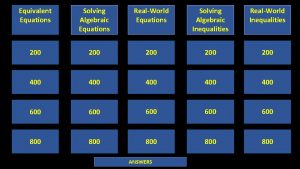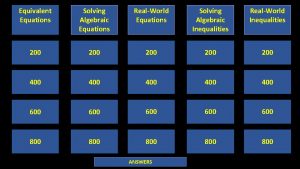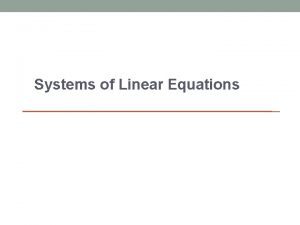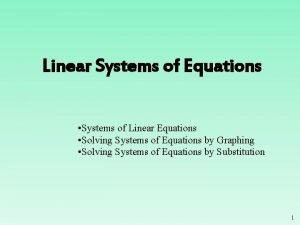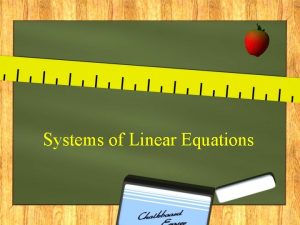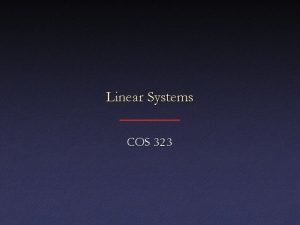Systems of Equations Solving Systems of Linear Equations














































- Slides: 46

Systems of Equations

Solving Systems of Linear Equations by Graphing

Systems of Linear Equations A system of linear equations consists of two or more linear equations. This section focuses on only two equations at a time. The solution of a system of linear equations in two variables is any ordered pair that solves both of the linear equations. Martin-Gay, Developmental Mathematics 3

Solution of a System Example Determine whether the given point is a solution of the following system. point: (– 3, 1) system: x – y = – 4 and 2 x + 10 y = 4 • Plug the values into the equations. First equation: – 3 – 1 = – 4 true Second equation: 2(– 3) + 10(1) = – 6 + 10 = 4 true • Since the point (– 3, 1) produces a true statement in both equations, it is a solution. Martin-Gay, Developmental Mathematics 4

Solution of a System Example Determine whether the given point is a solution of the following system point: (4, 2) system: 2 x – 5 y = – 2 and 3 x + 4 y = 4 Plug the values into the equations First equation: 2(4) – 5(2) = 8 – 10 = – 2 true Second equation: 3(4) + 4(2) = 12 + 8 = 20 4 false Since the point (4, 2) produces a true statement in only one equation, it is NOT a solution. Martin-Gay, Developmental Mathematics 5

Finding a Solution by Graphing • Since our chances of guessing the right coordinates to try for a solution are not that high, we’ll be more successful if we try a different technique. • Since a solution of a system of equations is a solution common to both equations, it would also be a point common to the graphs of both equations. • So to find the solution of a system of 2 linear equations, graph the equations and see where the lines intersect. Martin-Gay, Developmental Mathematics 6

Finding a Solution by Graphing y Example (-5, 5) Solve the following system of equations by graphing. 2 x – y = 6 and x + 3 y = 10 (-2, 4) (6, 6) (1, 3) (4, 2) (3, 0) x First, graph 2 x – y = 6. Second, graph x + 3 y = 10. The lines APPEAR to intersect at (4, 2). Martin-Gay, Developmental Mathematics (0, -6) Continued. 7

Finding a Solution by Graphing Example continued Although the solution to the system of equations appears to be (4, 2), you still need to check the answer by substituting x = 4 and y = 2 into the two equations. First equation, 2(4) – 2 = 8 – 2 = 6 true Second equation, 4 + 3(2) = 4 + 6 = 10 true The point (4, 2) checks, so it is the solution of the system. Martin-Gay, Developmental Mathematics 8

Finding a Solution by Graphing y Example Solve the following system of equations by graphing. – x + 3 y = 6 and 3 x – 9 y = 9 (6, 4) (0, 2) (3, 0) (-6, 0) (6, 1) x (0, -1) First, graph – x + 3 y = 6. Second, graph 3 x – 9 y = 9. The lines APPEAR to be parallel. Martin-Gay, Developmental Mathematics Continued. 9

Finding a Solution by Graphing Example continued Although the lines appear to be parallel, you still need to check that they have the same slope. You can do this by solving for y. First equation, –x + 3 y = 6 3 y = x + 6 (add x to both sides) y= x+2 (divide both sides by 3) Second equation, 3 x – 9 y = 9 – 9 y = – 3 x + 9 y= x– 1 (subtract 3 x from both sides) (divide both sides by – 9) Both lines have a slope of , so they are parallel and do not intersect. Hence, there is no solution to the system. Martin-Gay, Developmental Mathematics 10

Finding a Solution by Graphing y Example Solve the following system of equations by graphing. x = 3 y – 1 and 2 x – 6 y = – 2 (5, 2) (-1, 0) (2, 1) x (-4, -1) (7, -2) First, graph x = 3 y – 1. Second, graph 2 x – 6 y = – 2. The lines APPEAR to be identical. Martin-Gay, Developmental Mathematics Continued. 11

Finding a Solution by Graphing Example continued Although the lines appear to be identical, you still need to check that they are identical equations. You can do this by solving for y. First equation, x = 3 y – 1 3 y = x + 1 (add 1 to both sides) y= x+ (divide both sides by 3) Second equation, 2 x – 6 y = – 2 x – 2 y= x+ (subtract 2 x from both sides) (divide both sides by -6) The two equations are identical, so the graphs must be identical. There an infinite number of solutions to the system (all the points on the line). Martin-Gay, Developmental Mathematics 12

Types of Systems • There are three possible outcomes when graphing two linear equations in a plane. • One point of intersection, so one solution • Parallel lines, so no solution • Coincident lines, so infinite # of solutions • If there is at least one solution, the system is considered to be consistent. • If the system defines distinct lines, the equations are independent. Martin-Gay, Developmental Mathematics 13

Types of Systems Since there are only 3 possible outcomes with 2 lines in a plane, we can determine how many solutions of the system there will be without graphing the lines. Change both linear equations into slopeintercept form. We can then easily determine if the lines intersect, are parallel, or are the same line. Martin-Gay, Developmental Mathematics 14

Types of Systems Example How many solutions does the following system have? 3 x + y = 1 and 3 x + 2 y = 6 Write each equation in slope-intercept form. First equation, 3 x + y = 1 y = – 3 x + 1 (subtract 3 x from both sides) Second equation, 3 x + 2 y = 6 2 y = – 3 x + 6 (subtract 3 x from both sides) (divide both sides by 2) The lines are intersecting lines (since they have different slopes), so there is one solution. Martin-Gay, Developmental Mathematics 15

Types of Systems Example How many solutions does the following system have? 3 x + y = 0 and 2 y = – 6 x Write each equation in slope-intercept form, First equation, 3 x + y = 0 y = – 3 x (Subtract 3 x from both sides) Second equation, 2 y = – 6 x y = – 3 x (Divide both sides by 2) The two lines are identical, so there are infinitely many solutions. Martin-Gay, Developmental Mathematics 16

Types of Systems Example How many solutions does the following system have? 2 x + y = 0 and y = – 2 x + 1 Write each equation in slope-intercept form. First equation, 2 x + y = 0 y = – 2 x (subtract 2 x from both sides) Second equation, y = – 2 x + 1 (already in slope-intercept form) The two lines are parallel lines (same slope, but different yintercepts), so there are no solutions. Martin-Gay, Developmental Mathematics 17

Solving Systems of Linear Equations by Substitution

The Substitution Method Another method (beside getting lucky with trial and error or graphing the equations) that can be used to solve systems of equations is called the substitution method. You solve one equation for one of the variables, then substitute the new form of the equation into the other equation for the solved variable. Martin-Gay, Developmental Mathematics 19

The Substitution Method Example Solve the following system using the substitution method. 3 x – y = 6 and – 4 x + 2 y = – 8 Solving the first equation for y, 3 x – y = 6 –y = – 3 x + 6 y = 3 x – 6 (subtract 3 x from both sides) (divide both sides by – 1) Substitute this value for y in the second equation. – 4 x + 2 y = – 8 – 4 x + 2(3 x – 6) = – 8 – 4 x + 6 x – 12 = – 8 2 x = 4 x=2 (replace y with result from first equation) (use the distributive property) (simplify the left side) (add 12 to both sides) (divide both sides by 2) Martin-Gay, Developmental Mathematics Continued. 20

The Substitution Method Example continued Substitute x = 2 into the first equation solved for y. y = 3 x – 6 = 3(2) – 6 = 6 – 6 = 0 Our computations have produced the point (2, 0). Check the point in the original equations. First equation, 3 x – y = 6 3(2) – 0 = 6 true Second equation, – 4 x + 2 y = – 8 – 4(2) + 2(0) = – 8 true The solution of the system is (2, 0). Martin-Gay, Developmental Mathematics 21

The Substitution Method Solving a System of Linear Equations by the Substitution Method 1) Solve one of the equations for a variable. 2) Substitute the expression from step 1 into the other equation. 3) Solve the new equation. 4) Substitute the value found in step 3 into either equation containing both variables. 5) Check the proposed solution in the original equations. Martin-Gay, Developmental Mathematics 22

The Substitution Method Example Solve the following system of equations using the substitution method. y = 2 x – 5 and 8 x – 4 y = 20 Since the first equation is already solved for y, substitute this value into the second equation. 8 x – 4 y = 20 8 x – 4(2 x – 5) = 20 8 x – 8 x + 20 = 20 (replace y with result from first equation) (use distributive property) (simplify left side) Martin-Gay, Developmental Mathematics Continued. 23

The Substitution Method Example continued When you get a result, like the on the previous slide, that is obviously true for any value of the replacements for the variables, this indicates that the two equations actually represent the same line. There an infinite number of solutions for this system. Any solution of one equation would automatically be a solution of the other equation. This represents a consistent system and the linear equations are dependent equations. Martin-Gay, Developmental Mathematics 24

The Substitution Method Example Solve the following system of equations using the substitution method. 3 x – y = 4 and 6 x – 2 y = 4 Solve the first equation for y. 3 x – y = 4 –y = – 3 x + 4 (subtract 3 x from both sides) y = 3 x – 4 (multiply both sides by – 1) Substitute this value for y into the second equation. 6 x – 2 y = 4 6 x – 2(3 x – 4) = 4 (replace y with the result from the first equation) 6 x – 6 x + 8 = 4 (use distributive property) Continued. 8=4 (simplify the left side) Martin-Gay, Developmental Mathematics 25

The Substitution Method Example continued When you get a result, like the on the previous slide, that is never true for any value of the replacements for the variables, this indicates that the two equations actually are parallel and never intersect. There is no solution to this system. This represents an inconsistent system, even though the linear equations are independent. Martin-Gay, Developmental Mathematics 26

Solving Systems of Linear Equations by Addition

The Elimination Method Another method that can be used to solve systems of equations is called the addition or elimination method. You multiply both equations by numbers that will allow you to combine the two equations and eliminate one of the variables. Martin-Gay, Developmental Mathematics 28

The Elimination Method Example Solve the following system of equations using the elimination method. 6 x – 3 y = – 3 and 4 x + 5 y = – 9 Multiply both sides of the first equation by 5 and the second equation by 3. First equation, 5(6 x – 3 y) = 5(– 3) 30 x – 15 y = – 15 (use the distributive property) Second equation, 3(4 x + 5 y) = 3(– 9) 12 x + 15 y = – 27 (use the distributive property) Continued. Martin-Gay, Developmental Mathematics 29

The Elimination Method Example continued Combine the two resulting equations (eliminating the variable y). 30 x – 15 y = – 15 12 x + 15 y = – 27 42 x = – 42 x = – 1 (divide both sides by 42) Continued. Martin-Gay, Developmental Mathematics 30

The Elimination Method Example continued Substitute the value for x into one of the original equations. 6 x – 3 y = – 3 6(– 1) – 3 y = – 3 (replace the x value in the first equation) – 6 – 3 y = – 3 (simplify the left side) – 3 y = – 3 + 6 = 3 (add 6 to both sides and simplify) y = – 1 (divide both sides by – 3) Our computations have produced the point (– 1, – 1). Continued. Martin-Gay, Developmental Mathematics 31

The Elimination Method Example continued Check the point in the original equations. First equation, 6 x – 3 y = – 3 6(– 1) – 3(– 1) = – 3 Second equation, 4 x + 5 y = – 9 4(– 1) + 5(– 1) = – 9 true The solution of the system is (– 1, – 1). Martin-Gay, Developmental Mathematics 32

The Elimination Method Solving a System of Linear Equations by the Addition or Elimination Method 1) Rewrite each equation in standard form, eliminating fraction coefficients. 2) If necessary, multiply one or both equations by a number so that the coefficients of a chosen variable are opposites. 3) Add the equations. 4) Find the value of one variable by solving equation from step 3. 5) Find the value of the second variable by substituting the value found in step 4 into either original equation. 6) Check the proposed solution in the original equations. Martin-Gay, Developmental Mathematics 33

The Elimination Method Example Solve the following system of equations using the elimination method. First multiply both sides of the equations by a number that will clear the fractions out of the equations. Continued. Martin-Gay, Developmental Mathematics 34

The Elimination Method Example continued Multiply both sides of each equation by 12. (Note: you don’t have to multiply each equation by the same number, but in this case it will be convenient to do so. ) First equation, (multiply both sides by 12) (simplify both sides) Continued. Martin-Gay, Developmental Mathematics 35

The Elimination Method Example continued Second equation, (multiply both sides by 12) (simplify both sides) Combine the two equations. 8 x + 3 y = – 18 6 x – 3 y = – 24 14 x = – 42 x = – 3 (divide both sides by 14) Martin-Gay, Developmental Mathematics Continued. 36

The Elimination Method Example continued Substitute the value for x into one of the original equations. 8 x + 3 y = – 18 8(– 3) + 3 y = – 18 – 24 + 3 y = – 18 + 24 = 6 y=2 Our computations have produced the point (– 3, 2). Continued. Martin-Gay, Developmental Mathematics 37

The Elimination Method Example continued Check the point in the original equations. (Note: Here you should use the original equations before any modifications, to detect any computational errors that you might have made. ) First equation, Second equation, true The solution is the point (– 3, 2). Martin-Gay, Developmental Mathematics 38

Special Cases In a similar fashion to what you found in the last section, use of the addition method to combine two equations might lead you to results like. . . 5 = 5 (which is always true, thus indicating that there are infinitely many solutions, since the two equations represent the same line), or 0 = 6 (which is never true, thus indicating that there are no solutions, since the two equations represent parallel lines). Martin-Gay, Developmental Mathematics 39

Systems of Linear Equations and Problem Solving

Problem Solving Steps in Solving Problems 1) Understand the problem. • Read and reread the problem • Choose a variable to represent the unknown • Construct a drawing, whenever possible • Propose a solution and check 2) Translate the problem into two equations. 3) Solve the system of equations. 4) Interpret the results. • Check proposed solution in the problem • State your conclusion Martin-Gay, Developmental Mathematics 41

Solving a Problem Example Hilton University Drama club sold 311 tickets for a play. Student tickets cost 50 cents each; non student tickets cost $1. 50. If total receipts were $385. 50, find how many tickets of each type were sold. 1. ) Understand Read and reread the problem. Suppose the number of students tickets was 200. Since the total number of tickets sold was 311, the number of non student tickets would have to be 111 (311 – 200). Continued Martin-Gay, Developmental Mathematics 42

Solving a Problem Example continued 1. ) Understand (continued) Are the total receipts $385. 50? Admission for the 200 students will be 200($0. 50), or $100. Admission for the 111 non students will be 111($1. 50) = $166. 50. This gives total receipts of $100 + $166. 50 = $266. 50. Our proposed solution is incorrect, but we now have a better understanding of the problem. Since we are looking for two numbers, we let s = the number of student tickets n = the number of non-student tickets Martin-Gay, Developmental Mathematics Continued 43

Solving a Problem Example continued 2. ) Translate Hilton University Drama club sold 311 tickets for a play. s + n = 311 total receipts were $385. 50 Admission for students 0. 50 s Total receipts Admission for non students + 1. 50 n = 385. 50 Continued Martin-Gay, Developmental Mathematics 44

Solving a Problem Example continued 3. ) Solve We are solving the system s + n = 311 and 0. 50 s + 1. 50 n = 385. 50 Since the equations are written in standard form (and we might like to get rid of the decimals anyway), we’ll solve by the addition method. Multiply the second equation by – 2. s + n = 311 2(0. 50 s + 1. 50 n) = 2(385. 50) simplifies to s + n = 311 s – 3 n = 771 2 n = 460 n = 230 Now we substitute the value for n into the first equation. s + n = 311 s + 230 = 311 s = 81 Martin-Gay, Developmental Mathematics Continued 45

Solving a Problem Example continued 4. ) Interpret Check: Substitute s = 81 and n = 230 into both of the equations. First equation, s + n = 311 81 + 230 = 311 true Second equation, 0. 50 s + 1. 50 n = 385. 50 0. 50(81) + 1. 50(230) = 385. 50 40. 50 + 345 = 385. 50 true State: There were 81 student tickets and 230 non student tickets sold. Martin-Gay, Developmental Mathematics 46
 Solve systems of equations calculator
Solve systems of equations calculator Systems of linear and quadratic equations
Systems of linear and quadratic equations Metodo de gauss
Metodo de gauss Solving linear equations with variables on both sides
Solving linear equations with variables on both sides How do you solve multi step equations
How do you solve multi step equations Linear equations with fractions
Linear equations with fractions Solving linear equations: variable on one side
Solving linear equations: variable on one side Forming equations worksheet
Forming equations worksheet Multi step equations with variables on both sides
Multi step equations with variables on both sides Solve it
Solve it Inequality jeopardy
Inequality jeopardy Sr-71
Sr-71 Lesson 4 - solving linear equations and inequalities
Lesson 4 - solving linear equations and inequalities Solving
Solving Linear equation and inequalities
Linear equation and inequalities 1-2 lesson quiz solving linear equations
1-2 lesson quiz solving linear equations Lesson 4-2 absolute value inequalities
Lesson 4-2 absolute value inequalities Building and solving linear equations
Building and solving linear equations Solving linear trigonometric equations
Solving linear trigonometric equations Chapter 1 solving linear equations
Chapter 1 solving linear equations 1-2 lesson quiz solving linear equations
1-2 lesson quiz solving linear equations Solving equations with brackets
Solving equations with brackets Simultaneous equations exercise
Simultaneous equations exercise Lesson 1-2 solving linear equations
Lesson 1-2 solving linear equations Linear equations solving
Linear equations solving Solve equations with rational coefficients
Solve equations with rational coefficients Module 7 solving linear equations
Module 7 solving linear equations Forming and solving equations
Forming and solving equations Solving systems of linear inequalities by graphing
Solving systems of linear inequalities by graphing 11-1 solving linear systems by graphing
11-1 solving linear systems by graphing Lesson 9.1 solving linear systems by graphing answer key
Lesson 9.1 solving linear systems by graphing answer key Solving linear-quadratic systems by elimination
Solving linear-quadratic systems by elimination Solving linear systems graphically assignment
Solving linear systems graphically assignment System of inequalities quiz part 1
System of inequalities quiz part 1 How to solve linear quadratic systems algebraically
How to solve linear quadratic systems algebraically 6-3 solving linear systems using inverses and cramer's rule
6-3 solving linear systems using inverses and cramer's rule 6-6 solving systems of linear inequalities
6-6 solving systems of linear inequalities Solving systems of equations by substitution activity
Solving systems of equations by substitution activity Using elimination to solve systems
Using elimination to solve systems Solving systems of equations by elimination examples
Solving systems of equations by elimination examples Solving word problems using systems of equations
Solving word problems using systems of equations Solving systems by substitution word problems
Solving systems by substitution word problems Solving systems of nonlinear equations by elimination
Solving systems of nonlinear equations by elimination Lesson 3-1 solving systems of equations answers
Lesson 3-1 solving systems of equations answers Solving systems algebraically
Solving systems algebraically Systems of equations
Systems of equations Nonlinear equations examples
Nonlinear equations examples
